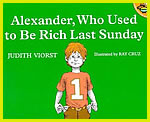Fourth Grade - Mathematics
Activities
Writing a Math Story
Financial and Economic Concepts: Scarcity and Choices, Goods & Services Fourth Grade – Mathematics
Fourth Grade – Mathematics
4 MD.2: Use the four operations to solve word problems involving distances, intervals of time, liquid volumes, masses of objects, and money, including problems involving simple fractions or decimals, and problems that require expressing measurements given in a larger unit in terms of a smaller unit. Represent measurement quantities using diagrams such as number line diagrams that feature a measurement scale.
Supplies: paper and pencil, Alexander, Who Used to be Rich Last Sunday.
After reviewing how to add and subtract using decimals, the students will listen to Alexander, Who Used to be Rich Last Sunday by Judith Viorst; then write their own story that involves adding and subtracting money. Students will be required to show their math work. A rubric will be used to assess the completed assignment.
![]() Lesson Details (pdf)
Lesson Details (pdf)
![]() Worksheet (pdf)
Worksheet (pdf)
Double Your Money
Financial and Economic Concepts: Saving and Financial Investing Fourth Grade – Mathematics
Fourth Grade – Mathematics
4.NBT.5: Use place value understanding and properties of operations to perform multi-digit arithmetic.
5.
Multiply a whole number of up to four digits by a one-digit whole number, and multiply two two-digit numbers, using strategies based on place value and the properties of operations. Illustrate and explain the calculation by using equations, rectangular arrays, and/or area models.
Time: 40 minutes
Materials: book, The King’s Chessboard by David Birch; handout
Begin a discussion about one million by asking students questions, such as “How much is one million?” “Do you consider one million a large number?” “Can you think of a number larger than one million?”
Students will choose between two options:
Option 1: one million dollars.
Option 2: one cent on the first day, two on the second, with the amount doubling and accumulating each day for one month.
![]() Complete Lesson Plan (pdf)
Complete Lesson Plan (pdf)
![]() A Million or Double? (pdf)
A Million or Double? (pdf)
Future Wants and Needs
Financial and Economic Concepts: Saving and Financial Investing Fourth Grade – Mathematics
Fourth Grade – Mathematics
4.OA.2-3: Use the four operations with whole numbers to solve problems.
2. Multiply or divide to solve word problems involving multiplicative comparison, e.g., by using drawings and equations with a symbol for the unknown number to represent the problem, distinguishing multiplicative comparison from additive comparison.
3. Solve multistep word problems posed with whole numbers and having whole-number answers using the four operations, including problems in which remainders must be interpreted. Represent these problems using equations with a letter standing for the unknown quantity. Assess the reasonableness of answers using mental computation and estimation strategies including rounding.

Time: 20 minutes
Materials: paper and pencils
 Saving resources causes individuals to plan for future wants and needs.
Saving resources causes individuals to plan for future wants and needs.
Ask students to carefully consider some future wants and needs, then determine the one that they would want to obtain first. Have students also list the cost of the item.
Have students pretend that they are getting $5.00 allowance per week. Ask them to figure out how long it will take them before they can have the thing they want.
In a class discussion ask students if the item is worth the amount of time needed to save the money to purchase it. Why?
I Can Be An Entrepreneur
Financial and Economic Concepts: Entrepreneurism Fourth Grade – Mathematics
Fourth Grade – Mathematics
4.NBT.4: Fluently add and subtract multi-digit whole numbers using the standard algorithm.
 Time: 20-40 minutes
Time: 20-40 minutes
Materials: Worksheets, pencils, construction paper for fliers, markers
Great introductory worksheets to help students begin to think about their earning power and ways they can earn money. Have students complete both worksheets then have a discussion so they can share their ideas.
Suggested discussion questions:
- What jobs did you choose to earn money?
- Why do you think they will be successful?
Create a graphic organizer that organizes the students' into categories -- [ie:, Enjoyable, Profitable, Consumer Demand, Parents Approve.]
Assess students completed worksheets. Consider the student’s reasons for choosing their jobs, the likelihood that they would be successful, their neatness, grammar, spelling, accuracy of the math, etc.
![]() Earning a Profit Answer Sheet (pdf)
Earning a Profit Answer Sheet (pdf)
![]() Jobs I Can Do to Earn Money (pdf)
Jobs I Can Do to Earn Money (pdf)
Stock Up!
Financial and Economic Concepts: Savings and Financial Investments Fourth Grade – Mathematics
Fourth Grade – Mathematics
4.MD.2: Use the four operations to solve word problems involving distances, intervals of time, liquid volumes, masses of objects, and money, including problems involving simple fractions or decimals, and problems that require expressing measurements given in a larger unit in terms of a smaller unit. Represent measurement quantities using diagrams such as number line diagrams that feature a measurement scale.

Time: 40 minutes
(Students can track their stock purchases for up to 10 days. This could be an at-home assignment or small amount of time given in class each day).
Materials: Computers (website – USAToday.com) or newspapers with stock reports, projector screen/Smart board, Math Journal (or work page), handout of Student Worksheet (stocks), any information needed to supplement lesson from General Information for Teachers page, and information about stocks, bonds, and profits here. Extra work page involving graphs here.
Students experience the real live ups and downs of the stock market by choosing and tracking individual stocks on a regular basis.




